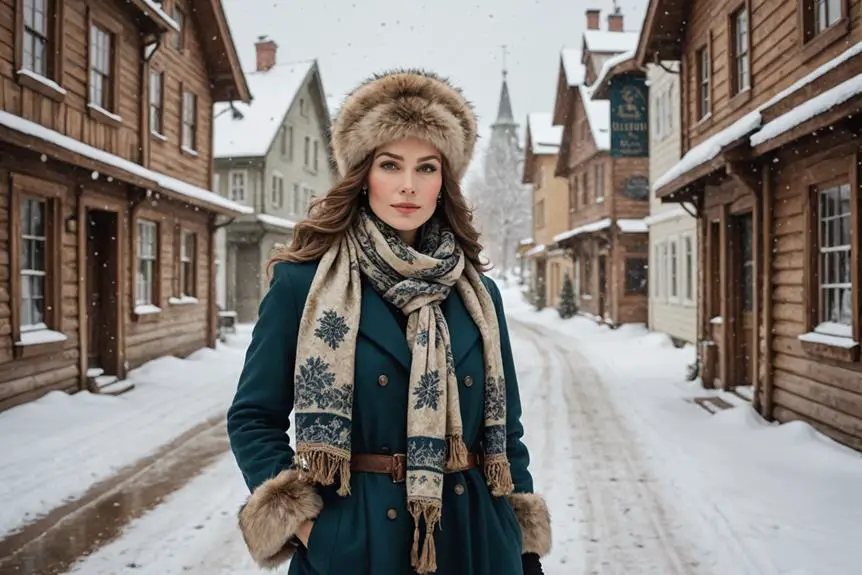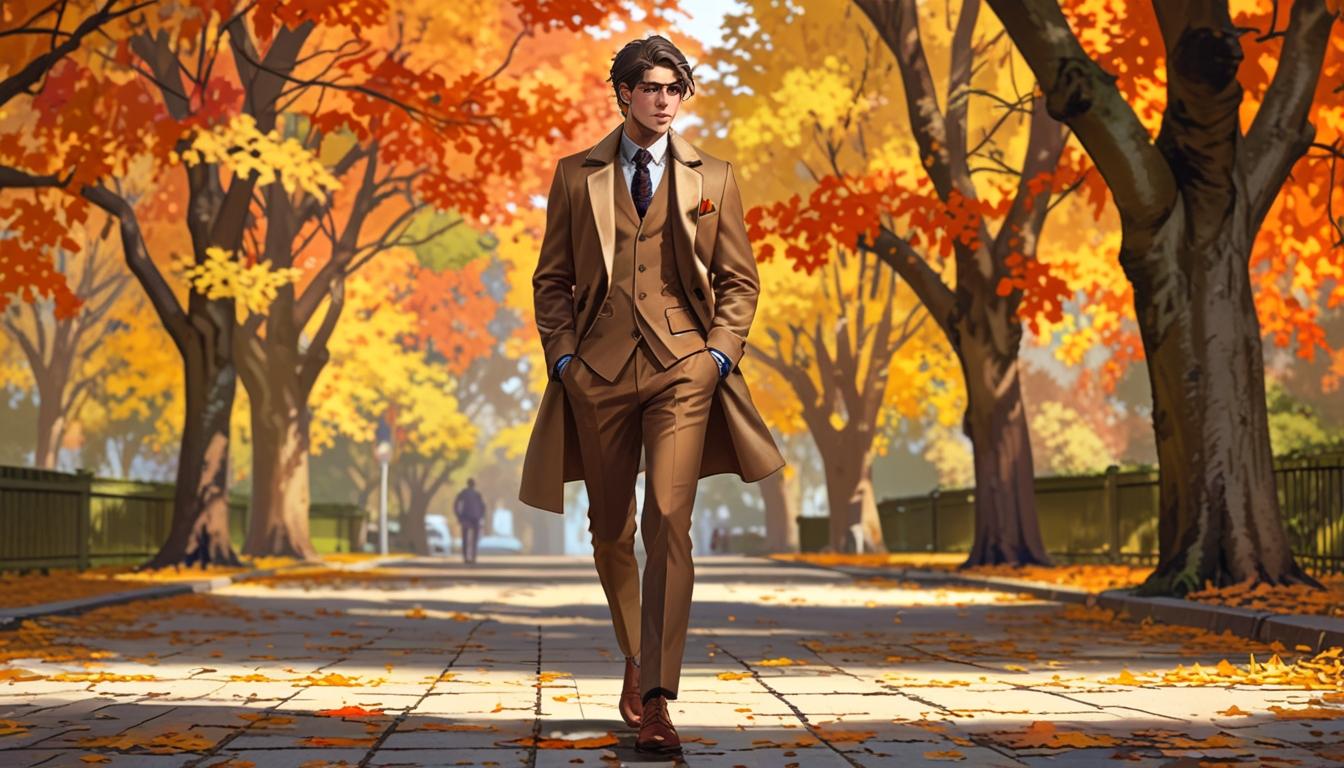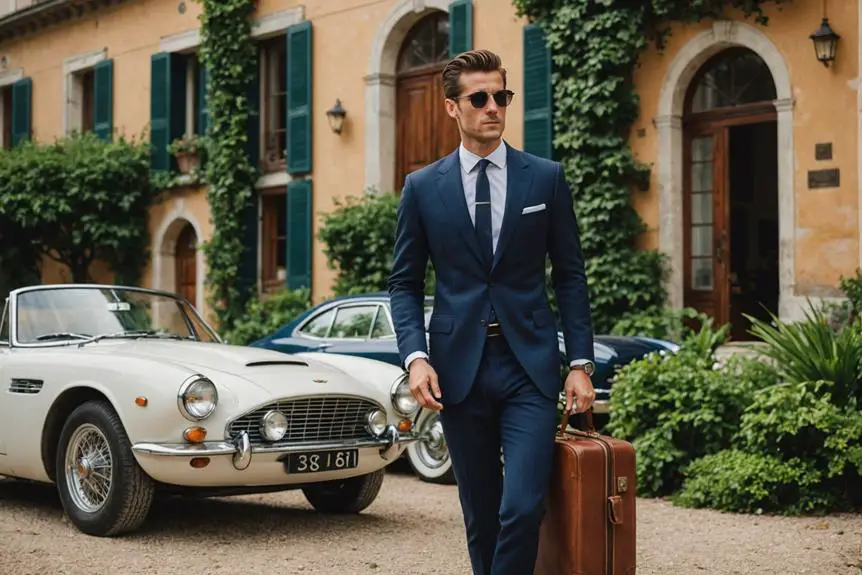When you think about "Doctor Zhivago," the stunning costumes often come to mind before the plot itself. You might notice how Lara's military coat and Tonya's fur hat not only reflect their characters but also the turbulent historical backdrop of the film. Phyllis Dalton's design choices didn't just serve the narrative; they shaped an entire era's fashion. As the film intertwined personal stories with cultural commentary, the impact of these outfits begs a closer examination. What do these choices reveal about the characters and the time they lived in?
Costume Design Highlights
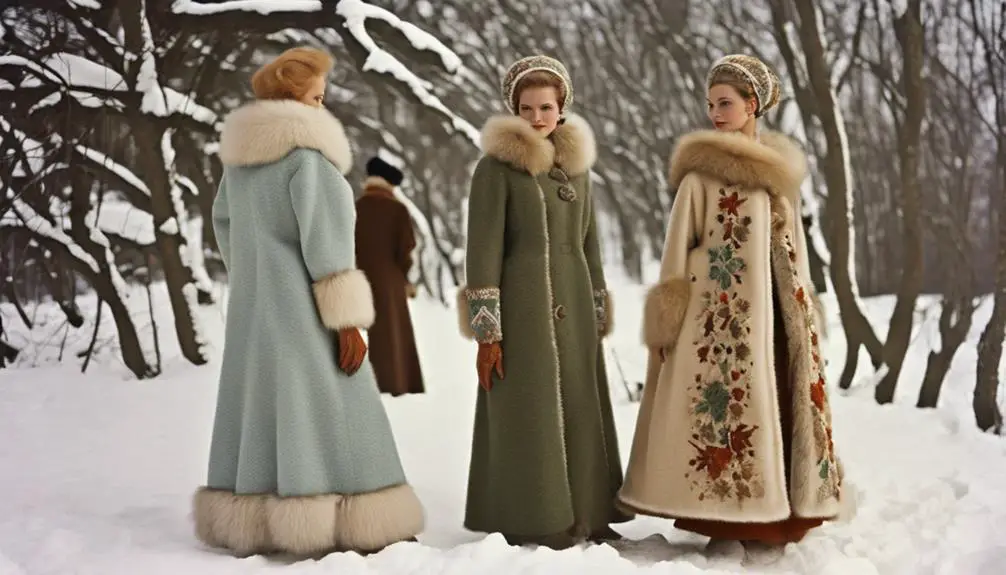
Phyllis Dalton's costume design for "Doctor Zhivago" is nothing short of iconic, earning her an Academy Award for Best Costume Design. Her brilliant work beautifully blends contemporary fashion with the film's early 20th-century historical context, creating a unique visual experience that resonates even today. One of the standout features of the costume design is the use of fur hats, which adds warmth and character to the characters while enhancing their stylish appeal.
For instance, Julie Christie, who plays Lara, dons an unforgettable black fur beret that has become synonymous with the "Zhivago look." This specific choice, while not historically accurate, showcases Dalton's talent for merging 1960s fashion trends with the period's essence, enchanting audiences and influencing fashion for years to come.
Lara's thick black knit ensemble and Tonya's elegant white fox-trimmed outerwear exemplify the film's visually striking costumes, making each scene a feast for the eyes. The oversized military coats worn by Julie Christie further contribute to the film's aesthetic, balancing femininity with a hint of ruggedness, which is truly reflective of the tumultuous times portrayed in the movie.
Dalton's work hasn't just made a mark on film; it's inspired renowned designers like Marc Bohan and Yves Saint Laurent, who drew elements from the "Doctor Zhivago" costumes to elevate their own collections. This enduring cultural impact underscores the brilliance of Dalton's costume design and the lasting allure of the film itself.
Iconic Wardrobe Pieces
Several iconic wardrobe pieces from "Doctor Zhivago" have left a lasting mark on fashion history. One of the standout items is Lara's gray oversized military coat paired with her iconic sable hat, which perfectly encapsulates the film's blend of modern and feminine styles. Designed by the talented costume designer Phyllis Dalton, this look became emblematic of the "Zhivago style," showcasing how fashion can tell a story just as powerfully as the script itself. The intricate details in these vintage outfits often require careful tailoring to guarantee the best fit, making knowledge of how to tailor a vintage knit dress invaluable for preserving their beauty and elegance.
Lara's outfits aren't just memorable for their aesthetic appeal; they also reflect practical elegance. Oversized sweaters and fingerless gloves create a cozy yet chic vibe, making her wardrobe both functional and stylish. Meanwhile, Geraldine Chaplin's character, Tonya, adds to the film's fashion legacy with her striking costumes, including a large fur hat and stole that enhance her visual presence on screen.
Phyllis Dalton's work in "Doctor Zhivago" didn't just earn an Academy Award; it inspired countless fashion trends for years to come. Designers like Marc Bohan for Christian Dior drew inspiration from the film, proving that the iconic wardrobe pieces resonate beyond their cinematic origins. The fur-trimmed collars and oversized coats defined a generation's style, illustrating how "Doctor Zhivago" has cemented its status as a cornerstone of fashion history. Whether you're a fan of classic cinema or simply appreciate timeless fashion, the impact of these pieces is undeniable.
Character Fashion Analysis
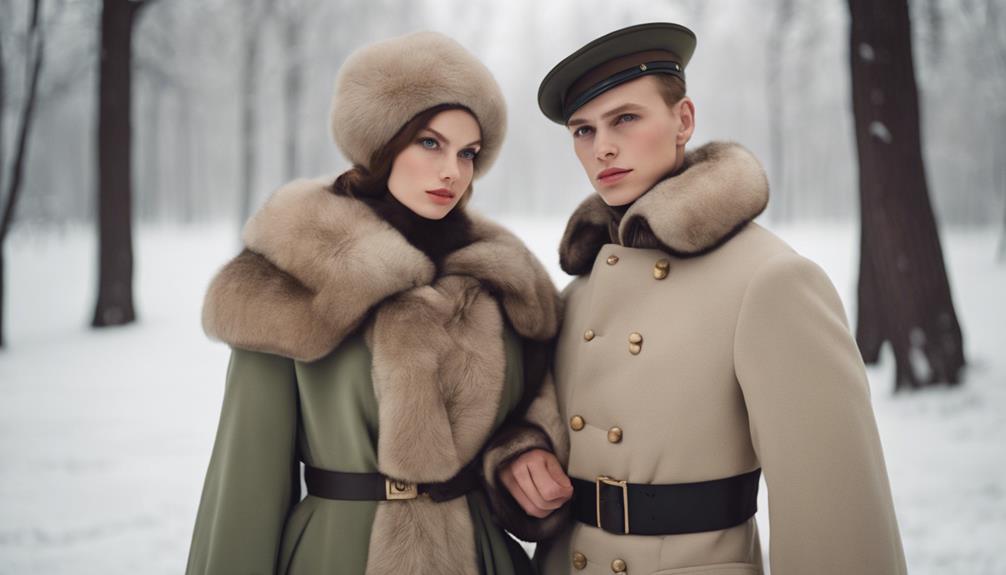
The fashion choices in "Doctor Zhivago" bring to life the personalities of its characters, with Lara and Tonya standing out as prime examples. Lara's wardrobe, designed by Phyllis Dalton, features oversized coats and feminine styles that embody the iconic "Zhivago Look." This representation has truly influenced fashion trends of the 1960s, showcasing how the film's costumes resonate with contemporary audiences.
Geraldine Chaplin's character, Tonya, adds another layer of richness to the film's fashion narrative. Her striking costume, adorned with a large fur hat, captures the essence of luxury, emphasizing the stark contrast between opulence and the film's revolutionary themes. You can't help but admire how these costumes reflect not only the characters' personalities but also the 1960s fashion sensibilities, which lean heavily towards modern elements like visible bras and bouffant hairstyles.
Lara's thick black knit ensemble, speculated to be made from mouton fur, gains significant screen time, particularly in intimate scenes, contributing to her character's visual identity. Notable outfits like Lara's gray oversized military coat and striking sable hat have become iconic representations of the film, inspiring numerous fashion trends post-release. These choices encapsulate the characters' emotional journeys, making their attire as memorable as the story itself. In "Doctor Zhivago," fashion isn't just about clothing; it's a powerful tool that shapes our understanding of character and narrative.
Historical Context and Inaccuracies
Set against the tumultuous backdrop of the Russian Revolution and World War I, "Doctor Zhivago" stumbles in its portrayal of these significant historical events. Directed by David Lean, the film offers sweeping visuals that might captivate you, but it ultimately fails to deliver an accurate historical context. Instead of focusing on the complexities of the Russian Revolution, it often treats these monumental changes as mere scenery for the romantic plot between Yuri and Lara. Critics argue that this approach undermines the film's dramatic impact, leaving it feeling superficial and disconnected from the actual history.
You might find it surprising that some reviews compare the film's historical accuracy to Wikipedia, suggesting it lacks informative value. While the characters' struggles are poignant, the film glosses over the real events that shaped their world, missing a chance to explore deeper storytelling and character development. The inaccuracies surrounding the Russian Revolution not only dilute the narrative but also diminish the emotional weight of the characters' experiences.
The focus on romance over revolutionary turmoil can leave you feeling that the real story of resilience and transformation is relegated to the background. Lean's adaptation captures the essence of love and loss beautifully, yet it sacrifices a genuine understanding of the historical context that could have enriched the film. Ultimately, while "Doctor Zhivago" remains an iconic cinematic experience, its treatment of history invites scrutiny and raises questions about the balance between storytelling and authenticity.
Cultural Impact of Outfits
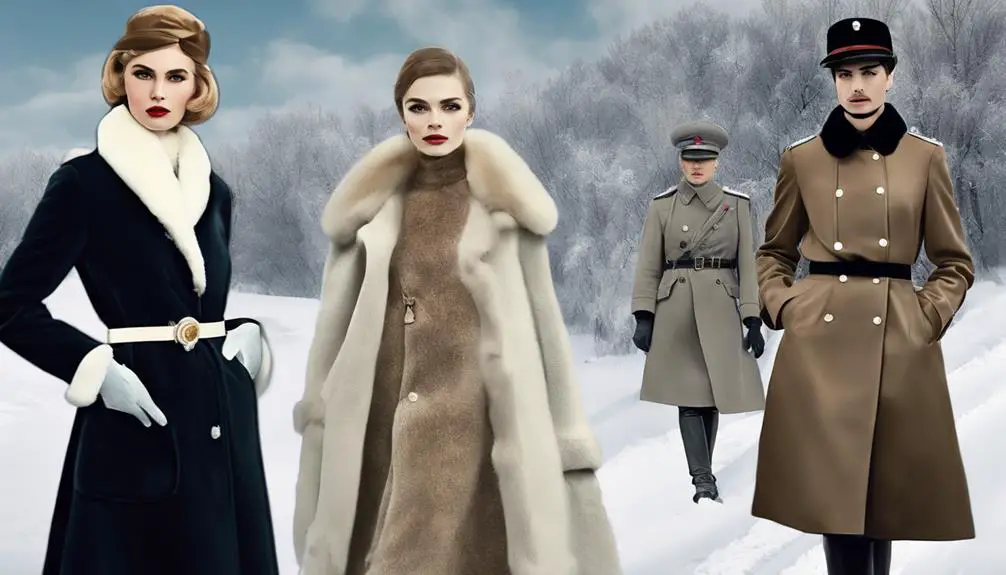
From the moment "Doctor Zhivago" hit theaters, its costumes left an indelible mark on fashion culture. The film's stunning outfits, particularly those designed by Phyllis Dalton for stars like Julie Christie and Geraldine Chaplin, sparked a wave of fashion trends in the 1960s. You'd notice a resurgence of fur-trimmed collars and oversized coats that echoed the film's dramatic aesthetic.
Notably, Marc Bohan for Christian Dior drew direct inspiration from the film for his autumn 1966 collection, incorporating military-style elements such as caps and greatcoats that reflected the film's unique vibe. The media blitz surrounding the film, including a Vogue article spotlighting its costumes, helped elevate its fashion influence just before its premiere, ensuring that audiences were captivated not just by the story, but by the stunning visuals.
The iconic fur hat worn by Julie Christie became a symbol of what fans affectionately dubbed the "Zhivago Look." This style transcended the film's release, continuing to inspire designers and fashion enthusiasts well into subsequent decades.
The cultural impact of "Doctor Zhivago" outfits is still evident today, with various fashion references and adaptations popping up everywhere. You can even find Etsy sections dedicated to Zhivago-inspired fashion, while advertisements as late as 1987 celebrated the film's enduring style. Clearly, "Doctor Zhivago" left a lasting legacy, blending cinema with fashion in a way that continues to inspire.
Frequently Asked Questions
Did Omar Sharif Wear a Wig in Dr. Zhivago?
Imagine Omar Sharif's hairstyle, a flowing tribute to historical accuracy. In the film's production, the wig controversy vanished; his natural look enhanced character portrayal. Behind the scenes, costume authenticity took center stage, ensuring an enthralling performance.
Who Is the Girl at the End of Dr. Zhivago?
The girl at the end symbolizes hope, embodying the emotional impact of her parents' love amidst historical turmoil. Her character analysis reveals thematic elements of resilience and continuity, deepening the story's character relationships and historical context.
Who Designed Costumes for Dr. Zhivago?
You'll discover that Phyllis Dalton, the visionary behind the costume design, expertly balanced character symbolism and historical accuracy. Her vibrant color palette and wardrobe choices left lasting fashion influences, shaping future designers' creative journeys and legacies.
What Country Was Doctor Zhivago Filmed In?
You'll find "Doctor Zhivago" filmed in Spain, where filmmakers navigated production challenges. The diverse landscapes served to represent Soviet history, blending cultural significance and historical accuracy through innovative cinematography techniques at various filming locations like Sierra de Guadarrama.
